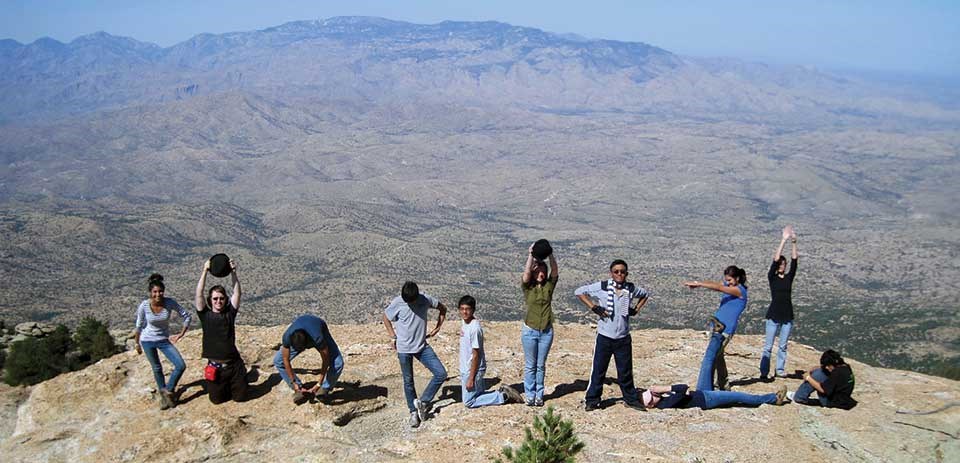Last updated: August 29, 2018
Article
Saguaro National Park 2011 NPS-NGS BioBlitz!
By Natasha Kline and Don Swan

inventoried birds, mammals, and invertebrates.
Here they take a break on Mica Mountain (8,613 feet [2,625 m] in elevation) to spell out "bioblitz" with their bodies.
While the park’s western Tucson Mountain District highlights the colorful flora of the lower Sonoran Desert, the eastern Rincon Mountain District rises up from the desert, through grassland and wood land, to conifer forests at over 8,600 feet (2,620 m) in elevation. Saguaro’s location within the “Sky Island” region of southeastern Arizona, where elements of Mexico’s Sierra Madre Occidental and the Rocky Mountains mix with those of the Chihuahuan and Sonoran deserts, creates a stunning landscape of biodiversity. The two disjunct districts of the park lie on opposite sides of Tucson, a diverse southwestern city with nearly one million residents, about 40% Hispanic and 40% under 18 years of age.
Our goals
Despite the park’s proximity to Tucson, many local residents have never visited. Conversely, biologists have long recognized the park’s distinct and diverse biota, so we already had extensive knowledge of its vertebrates and vascular plants. Thus, our goal was to bring scientists and Tucsonans, particularly those who had never been to the park, together to inven tory nonvascular plants, invertebrates, and other little-known “microbiota.” We were also determined that the bioblitz would not be a flash in the pan—that is, that the programs and data collected would be fol lowed up on so that this huge effort would create long-term benefits for the park.How we did it
Saguaro’s 2011 bioblitz was all about part nerships. We built on existing ties, espe cially with the Friends of Saguaro National Park, University of Arizona, and Arizona Sonora Desert Museum, and created many new ones. More than 300 volunteers and literally dozens of groups helped with everything from setting up booths at Base Camp to leading field trips.The major planning issue for our park, which does not have any road-accessible, large gathering places, was finding ap propriate sites for the events and arranging transportation to them. So we created many small events and organized a complex shuttle system to move people from off-site parking to Base Camp and to field sites. Getting schoolchildren safely into the backcountry added logistical complexity that included mule packing and on-site emergency medical technicians. For safety reasons we decided not to conduct the event in summer—when biodiversity is highest but temperatures are scorching— and chose October instead.
Highlights
The 2011 bioblitz was a huge and successful event in terms of outreach and science.- More than 5,000 participants, including more than 200 scientists and 2,100 schoolchildren, searched the park for life-forms. Students collected and identified lichens and insects; set up remote wildlife cameras; resurveyed a saguaro study plot established in 1941; and camped in the Rincon Mountains, where they studied butterflies, bryophytes, and birds.
- In the spirit of documenting biodiver sity in both districts of the park and in the city of Tucson in between, Dr. J. Michael Fay of the National Geographic Society conducted a “MiniTransect.” He began on the east side of the Rincon Mountains and, accom panied by a succession of park rangers and local biologists, documented every plant species he encountered while tra versing the Rincons, crossing Tucson, and hiking into Base Camp, where he kicked off the 2011 bioblitz.
- In the Science Tent, visitors used microscopes to examine local micro biota and discovered life-forms they had previously never heard of, including endophytes (bacteria or fungi that live within vascular plants) and tardigrades. Tardigrades, also called water bears or moss piglets, are micro scopic moss-dwelling creatures that constitute their own phylum; they are practically indestructible and surprisingly charming. Scientists discovered new species, too. Several bryophytes (mosses and liverworts) and endophytic fungi documented were new to the park, and some even new to science!
- Citizen scientists took their own photos and posted them on designated Web sites, such as Project Noah (https://www.projectnoah.org /missions/6986014), where they could be tallied.
- When the original count of 859 identified species was revealed on the afternoon of 22 October 2011, we knew it was just the beginning. Scientists continue to identify specimens, and the latest number has grown to 1,106— and we are still counting.
- Not only was the bioblitz about sci ence, it was a celebration of biodiver sity and Saguaro National Park that included art exhibits, video produc tion, dance, and a published poetry project.
What we learned
Our goals of getting people into the field and expanding our knowledge of the park’s microbiota were met beyond our wildest expectations. Thousands of visi tors explored the park in a meaningful, hands-on way and many new species were documented.As the involvement with our partners deepened, the bioblitz developed a life of its own. Most park staff were too busy to take in more than a sliver of this enormous event. Since then, we have continued to be amazed by new discoveries and experi ences from those two days—including new photos, videos, poetry, and art—that teach us and our visitors things about our park that we never knew before.
